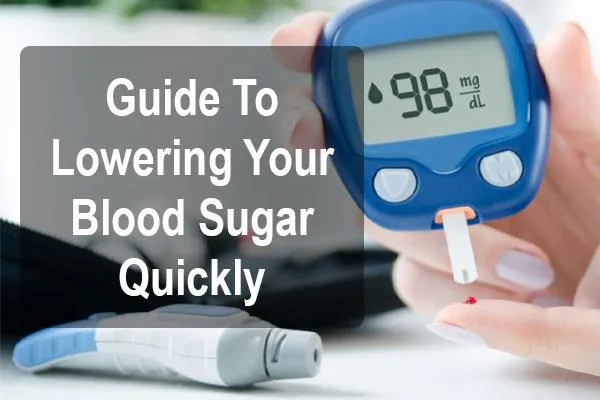
How to Lower Your Blood Sugar Quickly (Safely & Proven)
How to Lower Your Blood Sugar Quickly: What Works, What Doesn’t, and When to Get Help
Medical safety first. If your glucose is very high and you have symptoms like excessive thirst, frequent urination, nausea/vomiting, belly pain, fruity-smelling breath, or confusion, seek urgent care—these can signal diabetic ketoacidosis (DKA). Many experts advise checking for urine ketones if your blood glucose is ≥240 mg/dL; if ketones are present, do not exercise and contact your clinician. Mayo ClinicAmerican Diabetes Association+1
TL;DR
For mild to moderate spikes, the fastest, safe at-home levers (for most people) are: a 10–30 minute walk right after eating, hydration, and lower-glycemic follow-up snacks/meals. Vinegar with meals can modestly blunt the post-meal rise for some. PubMed+2PubMed+2News-MedicalPMC
If you use insulin or other glucose-lowering meds, follow your prescribed correction plan and your clinician’s guidance. Use extra caution if you suspect ketones or illness. American Diabetes Association
“Quick fixes” from supplements are often overstated; some ingredients have supportive data (e.g., vinegar; cinnamon, mixed evidence), but effects are modest vs. food, movement, and medications. PubMed+1PMC
The “Quickly” Question: When is a fast drop appropriate—and when is it risky?
Appropriate: post-meal elevations in otherwise stable adults without ketones or severe symptoms. Short activity and savvy food choices can help. PubMed
Risky: very high readings (often ≥240–300 mg/dL), illness, positive ketones, or symptoms of DKA. In these scenarios, follow your clinician’s plan and consider urgent evaluation. American Diabetes Association+1Mayo Clinic
What Lowers Blood Sugar Fast (Backed by Evidence)
1) Move—ideally right after eating
Even 10 minutes of walking immediately after a carb-containing meal can reduce the glucose peak; 30 minutes of brisk post-meal walking also improves glycemic response. If glucose is high with ketones, skip exercise and call your clinician. News-MedicalPubMedAmerican Diabetes Association
Practical play: set a 10–20 minute “meal walk” timer. Indoors counts (hallway laps, stairs, light body-weight circuits).
2) Hydrate
Low habitual water intake is linked with impaired glucose regulation; increasing water can lower vasopressin/copeptin and is associated with better glycemic control. While hydration isn’t a drug-like fix, it helps—especially if you’re dehydrated. PubMedPMC
Practical play: 8–16 oz water with or right after meals; more in hot weather or when active (per clinician advice).
3) Acidify the meal (vinegar)
Vinegar (acetic acid) can blunt post-meal glucose and insulin responses; small trials—even a bedtime dose—showed lower fasting morning glucose in some with impaired glucose regulation. Expect modest effects; always dilute to protect teeth and esophagus. PubMedDiabetes Journals
Practical play: 1–2 tsp (5–10 mL) diluted in water, or as vinaigrette with carbs.
4) Protein/fiber “rescue”
If you’ve eaten a high-GI snack, following with protein + fiber (e.g., Greek yogurt + chia; nuts + veggie sticks) can reduce further glycemic excursion versus more refined carbs. (General nutrition guidance within ADA Standards supports lower-GI, higher-fiber patterns.) American Diabetes Association
What Helps Over Weeks (Not “instant” but important)
Cinnamon: Meta-analyses of RCTs report mixed but overall possible improvements in fasting glucose and lipids; dose matters and results vary. Don’t expect an acute, large drop. PubMed+1
Medication optimization: Short-acting GLP-1 receptor agonists primarily reduce post-meal spikes via gastric-emptying effects; long-acting forms help overall control. Discuss with your clinician. PMC+1
Consumer Voices: What People Say They Want (Common Themes)
From reviews and community forums across major retailers and diabetes communities, shoppers consistently report they’re looking for:
Predictable, gentle effects (no jitters or GI distress)
Transparent labels with clinical-range doses
Third-party testing (purity, potency)
Stack-friendliness (can be taken with fiber, magnesium, or omega-3s as advised)
(These are aggregated themes rather than endorsements of specific products.)
Why Premium Glyco Can Be a Smart Pick (What to Look For & How to Prove It)
We can’t claim drug-like “quick fixes,” but a well-designed glucose-support formula can complement food and movement. Here’s the bar Premium Glyco should clear—and how to show readers it does:
Evidence-aligned ingredients at clinically relevant doses
Examples often studied for glycemic support: berberine, cinnamon extract (type & dose specified), chromium, alpha-lipoic acid, gymnema, bitter melon, inositol, magnesium. Document dose ranges against published trials on the product page/FAQ. (Mixed evidence is fine—be transparent and avoid overpromising.)
Formulation transparency
No “proprietary blends” hiding under-dosed actives. Full milligrams per ingredient.
Third-party testing
Publish recent COAs (Certificate of Analysis) for identity, purity (heavy metals), potency, and microbes. Ideally NSF/USP-style verification or equivalent lab reports.
Gastro-friendly design
Use forms with better tolerability (e.g., R-ALA vs ALA if heat stability is an issue; chelated minerals). Call out food-with or split-dose guidance.
Real-world guidance
Clear instructions on how to pair with meals, what to monitor (e.g., SMBG/CGM trends), and who should avoid it (pregnancy, certain meds like anticoagulants, etc.).
No medical overreach
Position as adjunctive support alongside diet, movement, sleep, and clinician-directed care—not a treatment or cure.
If Premium Glyco already meets these standards, it’s easy to argue it’s a top option because it delivers clinical-range dosing + proof of purity + transparent education—the three things consumers say they want most.
How to Use (General, Non-medical Guidance)
Start with one change you control today: a 10–20 minute post-meal walk and water with meals. PubMed+1News-Medical
If you add a supplement like Premium Glyco, track fasting glucose and 1–2-hour post-meal values for 2–4 weeks to see if it’s helping you.
Always discuss new supplements with your clinician—especially if you take glucose-lowering medications.
References & Key Guidance
ADA: Managing hyperglycemia; when not to exercise (check ketones ≥240 mg/dL). American Diabetes Association
DKA “red flags” & when to seek urgent care (Mayo Clinic). Mayo Clinic
Post-meal activity lowers glucose (10–30 minutes). News-MedicalPubMed
Hydration & glucose regulation (observational + interventional physiology). PubMedPMC
Vinegar attenuates postprandial glucose; bedtime trial shows lower morning glucose in some. PubMedDiabetes Journals
Cinnamon: mixed but suggestive evidence in meta-analyses/RCTs. PubMed+1
GLP-1 RAs: mechanisms affecting post-prandial glycemia. PMC+1
Standards of Care 2025 for context. American Diabetes Association









